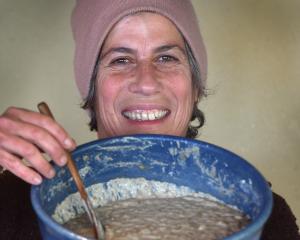

Eating a variety of foods is known to bring plenty of benefits. To have a healthy body we need a diet made of different foods to provide us with all our nutritional needs. Some say we do best when eating up to 30 different types of foods a week! And as we improve our health we also aid systems around us — in this case, food production systems. As we demand more vegetables, grains and fruits, there will be farmers willing to grow more crops, and increasing crop diversity brings with it improved soil health. So food diversity is a crucial concept.
"The Earth’s biodiversity is key to human survival on the planet. Plant diversity incentivises farmers to grow a variety of plants and is a key tenet behind regenerative agriculture; each plant puts different nutrients into the soil for other plants," Cool Beans co-founder Tyler Mayoras said.
Mr Mayoras champions plant foods and especially beans and legumes: "Legumes are both an incredible superfood and eco-warriors, pulling carbon out of the air and sequestering it into the soil. As one of the few plants that put nitrogen into the soil they are key for healthy crop rotation and healthy soil. Planting more beans in rotation reduces the need for carbon-intensive, liquid nitrogen fertiliser."

Just as crop diversity maintains a healthy community of soil microbes, a variety of plant foods is beneficial to restore and keep a healthy gut microbiome — maintaining a good immune system and good mental health.
One great way to increase your intake of different plant-based foods, is a meal-in-a-bowl method — "the Buddha bowl" — the plant-based versions of which typically include a mix of raw or steamed veges, some protein such as tofu, beans or tempeh, cooked whole grains, sprouts, toppings, nuts and seeds and a sauce. The ingredients are arranged in beautiful circular placements with bright coloured vegetables to create a visual as well as a taste delight.
You can choose to follow a recipe like the ones provided here or get creative and cook with what you have. It takes some thinking ahead, choosing the ingredients and flavour and style of the bowl you would like. To prepare the bowl meals, we need to cook and chop all the different components and ingredients in advance, then we put it all together and serve. It is a very satisfying and easy way to be healthy — enjoy!

Job’s tears, shiitake and tofu Buddha bowl with tamari and ginger sauce
Ingredients
1 cup Job’s tears
200g block of tofu (firm or soft, but not silky tofu)
1 packet of sliced dried shiitake or 8 whole fresh — sliced, (2 mushrooms per serve)
1 broccoli, divided into florets
3cm finger of fresh ginger
Fresh coriander
Tamari (wheat-free naturally brewed soy sauce)
Sprouts (Mung bean, alfalfa, broccoli or pea sprouts)
Chilli (optional)
Method
To cook Job’s tears, place in a medium-size pot, rinse in cold water then toast the grains in the pan, top up with water at least 1cm above the grains and bring to the boil with the lid on.
Once boiling, turn heat to med/low (check that it is not too low, so the grain is still cooking) continue to cook on low for 40-50 minutes until the grains are al dente.
To prepare the tofu, take the tofu out of its packet, drain the water, wrap in a tea towel and set aside.
Prepare the marinade by combining ⅓cup of water, ⅓ cup tamari soy sauce, 4slices of fresh ginger and 1 clove garlic. Cut the tofu into cubes and shallow-fry in a hot pan. When crispy on all sides pop tofu into the marinade while still hot.
Drain the shiitake, conserving the water, and place in the pan you used for the tofu. Add the soak-water a little at a time, keeping the mushrooms covered. Cook until tender and set aside.
Prepare the sauce by using the marinade from the tofu, whisk it with a little sesame oil.
Dry-roast sunflower seeds, pumpkin seeds and sesame seeds for toppings.
Cut the broccoli into individual florets, steam, and set aside.
Now assemble the Buddha bowl. First place the grain on the bottom of the bowl and pile it a little more in one half of the bowl so it is visible when all other ingredients are added.
Place the broccoli next to the mound of grain, then place the tofu and shiitake. Top with sprouts and the seeds, drizzle with some sauce, saving some extra to top-up as you eat at the table.

Broad bean and millet Buddha bowl with harissa tahini sauce
Ingredients
1 cup hulled millet
⅔ cup broad beans — shelled and steamed
⅔ cup steamed edamame
⅛ cup olive oil
1 tomato cubed, 1 avocado peeled and cubed, ½ red onion thinly sliced. Mix and season with olive oil, salt and pepper.
2 Tbsp tahini
1 Tbsp of lemon juice
½ tsp salt
1 tsp harissa
Some fresh basil, chopped
Method
Cook the millet — place in a medium size saucepan, cover with water (1cm over the grain) and bring to the boil. Turn the heat down and simmer with the lid tilted until water has been soaked up. Turn heat off, place the lid on and set aside for 10 minutes.
Mix the edamame and broad beans with a little olive oil and salt and pepper.
To make the sauce, place tahini and lemon juice and salt in a small bowl, add ⅛ cup water and whisk to make a paste. Keep adding spoonfuls of water to create a smooth sauce consistency. Add the harissa and taste — add salt if needed.
Assemble the bowl, starting with the millet. Add the beans on one side and the avocado and tomato salad on the other. Top with tahini sauce and sprinkle with fresh basil.

Chickpea and potato turmeric basmati Buddha bowl with tamarind sauce
Ingredients
½ cup dried chickpeas, soaked overnight and cooked
3 large potatoes, cooked whole and cut into 2cm cubes
1 cup basmati rice
¼ tsp turmeric
½ tsp paprika
4 Tbsp olive oil
1 carrot, grated and mixed with sprouts
Pickled beetroot
¼ cup almonds dry roasted.
For the sauce
1 Tbsp tamarind paste
½ cup pitted dates
½ cup water
¼ tsp of these spices: ground cumin, ground fennel, red chilli (optional), ground ginger
½ tsp salt
1 tsp sugar (optional)
Mix all together in a small saucepan, bring to the boil and cook for 5-7 minutes, set aside to cool.
Method
To cook the rice place in a medium size saucepan and rinse in cold water, cover with water 1cm above the grain, add turmeric, a drop of olive oil and a pinch of salt, and bring to the boil. Tilt the lid once boiling and steam on low heat. Place the lid on properly once the water has all soaked in and set aside for 10 minutes.
Place potatoes in a bowl and toss with olive oil salt and paprika, then place on a lined oven tray and roast for 20 minutes at 180degC.
Assemble the bowl by first placing the rice, add the potatoes on one side and the chickpeas on another, add the carrot and sprouts, the pickled beetroot and drizzle with the sauce. Sprinkle with roasted almonds.
Pottery for the photoshoot was provided by Dave Milne Ceramics, 145 Stuart St Dunedin












